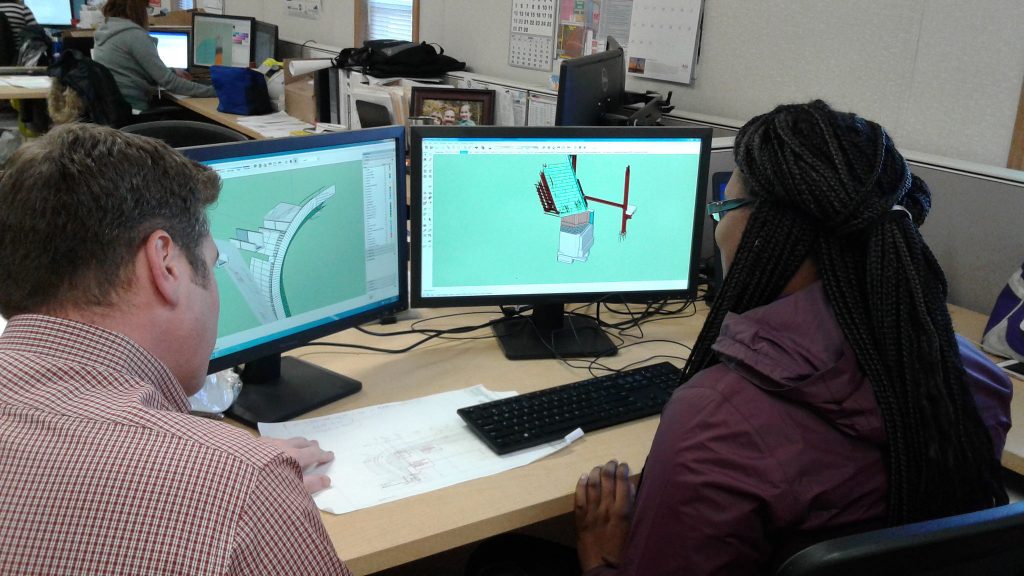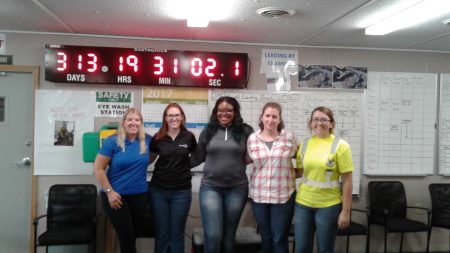Apprenticeship Program Builds The Future
MPS youth apprenticeship program serves 250 students this academic year

LaResha Love works with integrated construction manager Shaun Hester at Mortenson Construction. Photo courtesy of Terri Salzer.
LaResha Love says working for Mortenson Construction changed her life.
Beginning in January when she was a senior at Bradley Tech High School until she left for college at University of Wisconsin-Stout a few weeks ago, Love worked as a youth apprentice for Mortenson at the new Milwaukee Bucks arena construction site.
This academic year, 250 MPS students will have the opportunity to participate in the statewide youth apprenticeship program – up from 46 last year – made possible by Wisconsin Department of Workforce Development (DWD) funding.
As youth apprentices, high school juniors and seniors work at local companies based on their subject interests, earning income and experience. MPS works with the employers to match the students with mentors.
It’s a win-win situation for both employers and students, explained Eric Radomski, career and technical education manager at MPS. Many high school students in Milwaukee need and want paid work, and the youth apprentices help employers “fill a pipeline,” Radomski said.
The program evaluates students’ attendance, grades, behavior and interests. When a student applies for an apprenticeship, the employer knows he or she is interested in working at the company and has had some instruction to prepare for the job.

LaResha Love worked for Mortenson Construction as part of Milwaukee Public Schools’ youth apprenticeship program. Love (center) poses with mentors Bridget Kraus, Vanessa Nsubuga, TJ Lewis and Carina Sowinski. Photo courtesy of Terri Salzer.
The statewide youth apprenticeship program has been connecting students to employers since the 1990s. Because MPS’s program will experience exponential growth this year, school leaders must now find more employers to participate.
“They need to be aware of this pipeline of young talent,” said Terri Salzer, MPS’s youth apprenticeship coordinator. In many cases, employers assume young people lack the interest, related coursework and experience to work successfully in a professional environment, she noted.
Cathy Crary, DWD section chief for the youth apprenticeship program, called student workers “an untapped resource.”
“Milwaukee should be our shining star in the state, and we think we can get there,” she said.
When asked about specific challenges facing Milwaukee youth apprentices, Love, Radomski, Salzer and Crary all spoke about transportation.
Commonly, Milwaukee junior and senior high school students do not have driver’s licenses and rely on public transportation. Consequently, any work opportunity that is not near a county bus line is usually out of the question, and even locations in the city can take more than an hour to reach via bus.
Radomski said the youth apprenticeship program has had to turn down employment opportunities for students in other counties because of the transportation issue.
In fact, Mortenson initially offered Love a position in its Brookfield office, but since she has neither a car nor a driver’s license, she would have had to take the bus an hour each way every day. Fortunately for her, Mortenson accommodated her by assigning her to work at the downtown construction site.
School communities can push for local policy changes to ease the transportation burden, Crary said. Designated school buses could drive students to work sites, and more programs could assist teens in obtaining licenses.
MPS has recently started one such program, called MPS Drive, which offers free driver education for all students.
Many MPS students lack a clear understanding of the kinds of work and careers available to them, Radomski said.
Love, who thought she would pursue computer engineering, began her youth apprenticeship at Mortenson working on virtual mockups, models and blueprints. She quickly found the work boring and difficult. Come summer, she started shadowing the superintendent who oversees all work around the Bucks construction site, and that really sparked her interest.
Now, she studies construction management at UW-Stout and hopes to become a project manager one day.
“Mortenson changed my life,” she said. “At first, I was there for myself and myself only. But my second week there, I realized that’s not the attitude you can have there.”
Love said her employers were all so welcoming and friendly, which pushed her to make the best of her experience by exploring different positions and making connections with leaders and mentors.
By the time she was finishing high school classes, she was grateful to be given the opportunity to stay at Mortenson for the summer. Love hopes to return to there during the summers she is in college.
Many MPS youth apprentices continue working with their employer while they advance their education, whether that’s at a technical college or a traditional four-year institution, Salzer said.
“I’m lost for words when it comes to talking about the youth apprenticeship because it’s the best experience you could ever have in life,” Love said.
“If I wouldn’t have had this opportunity to work for Mortenson, I wouldn’t have known my major. I don’t know what I would do with my life.”
This story was originally published by Milwaukee Neighborhood News Service, where you can find other stories reporting on eighteen city neighborhoods in Milwaukee.






















Beginning an apprenticeship in high school is optimal. The short-term benefits are income and increased graduation rate. The long-term benefit is a well-paid occupation.
Hopefully, this will be expanded to more schools for 1500–2000.
Indeed transportation to outlying counties is a major barrier. The Milwaukee County Executive could solve this problem. It’s a matter of willingness to do it.
There is a pattern of restricting People of Color at the western and northern county boundaries. This unconscienable.